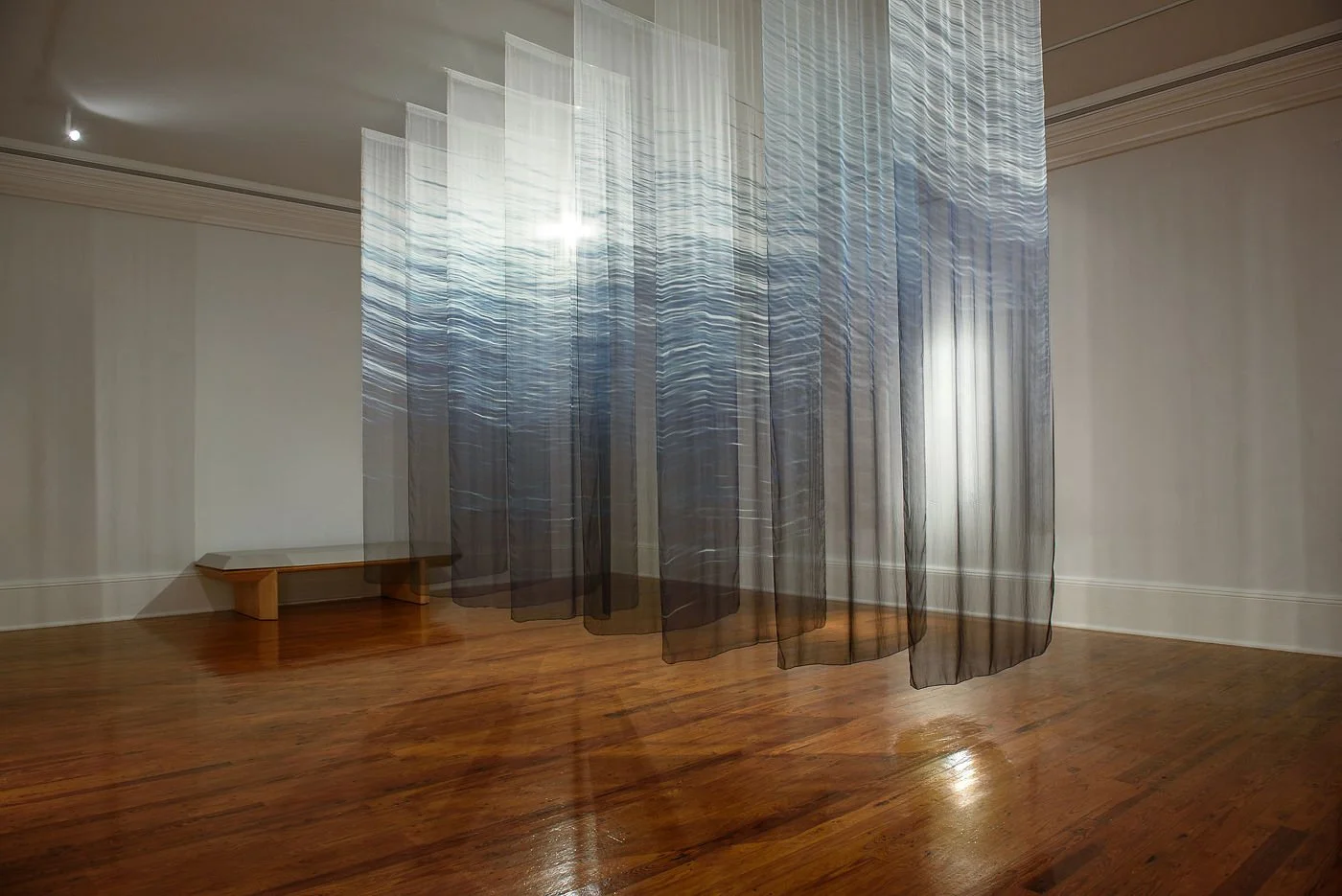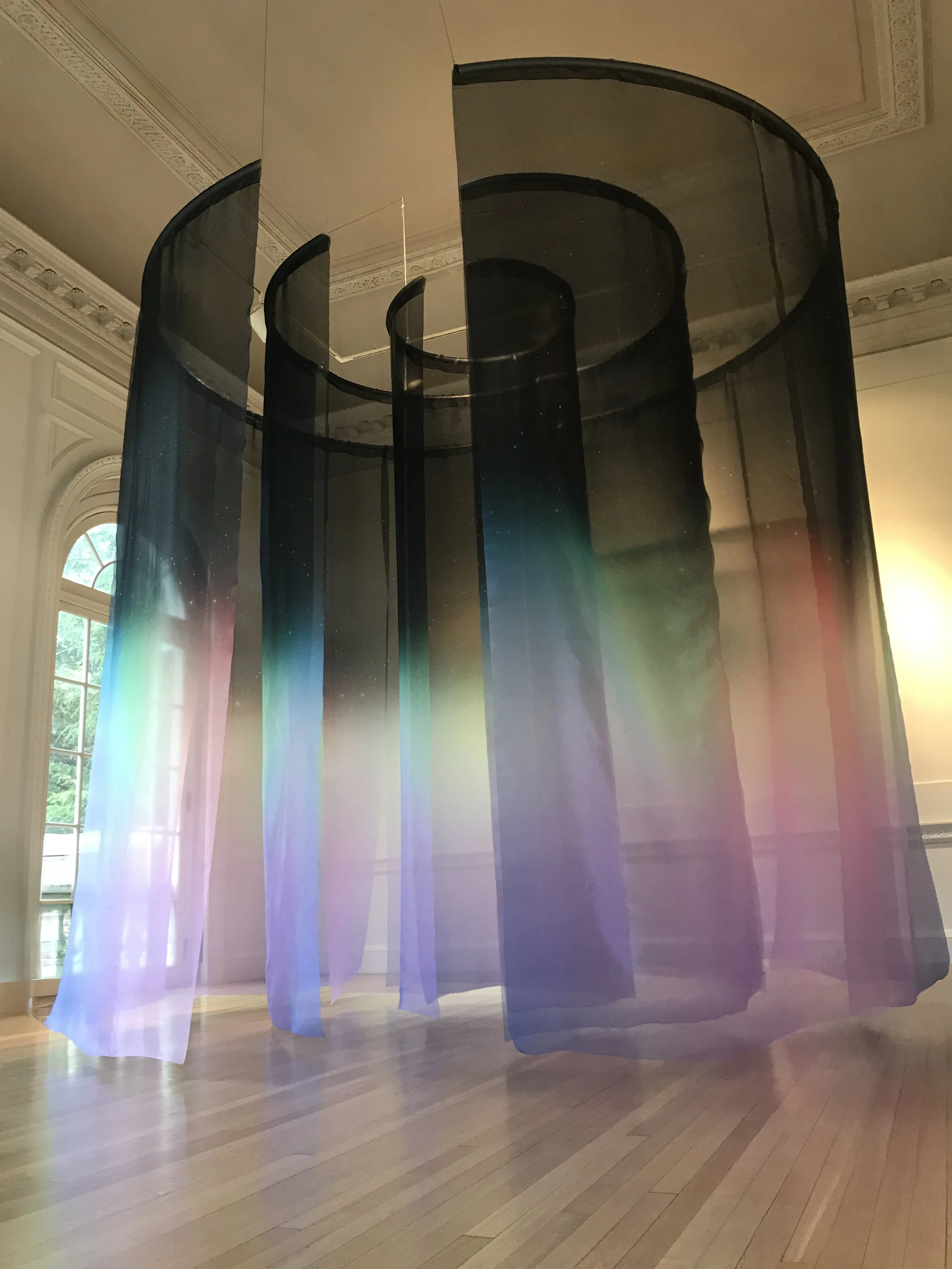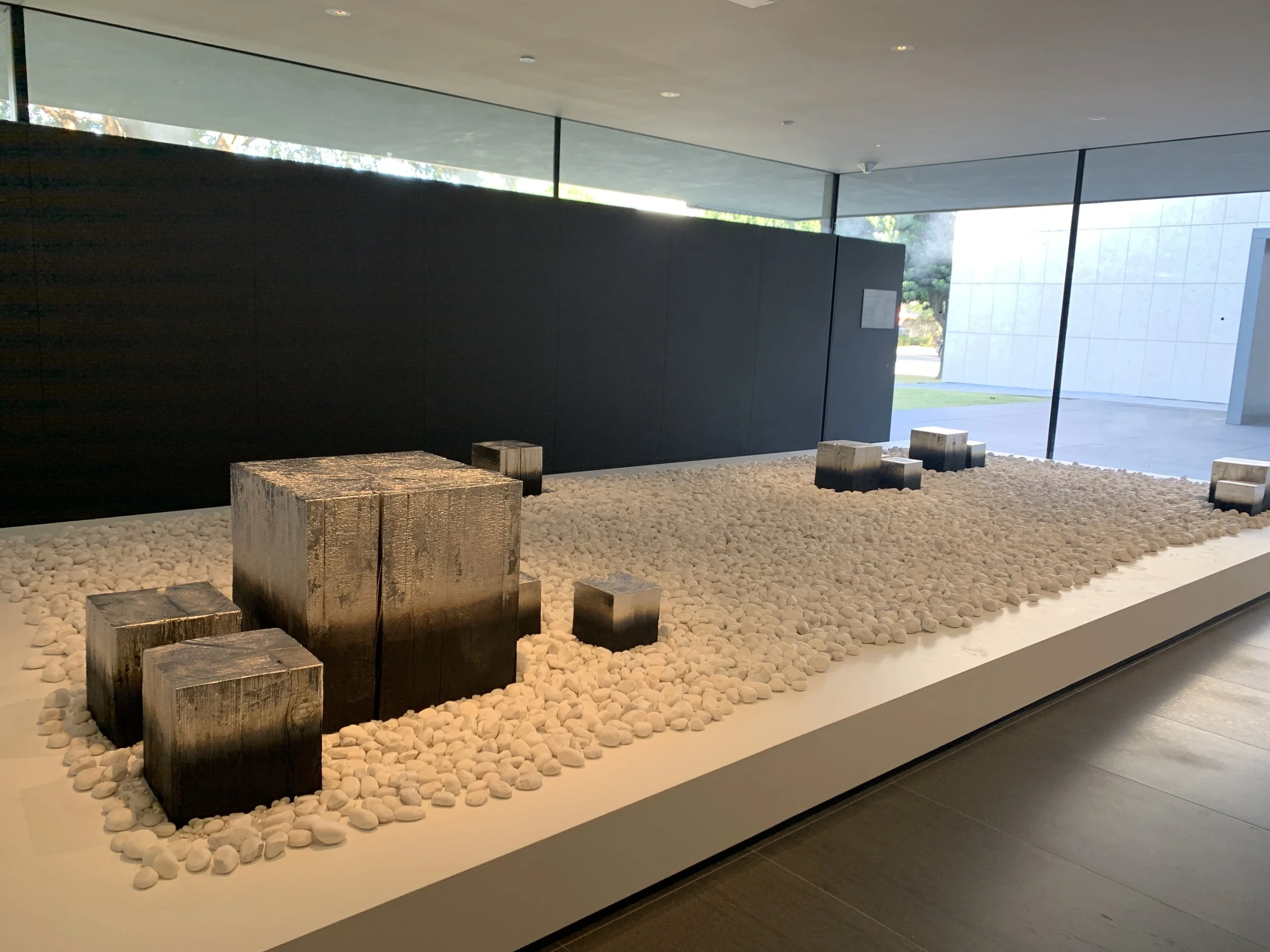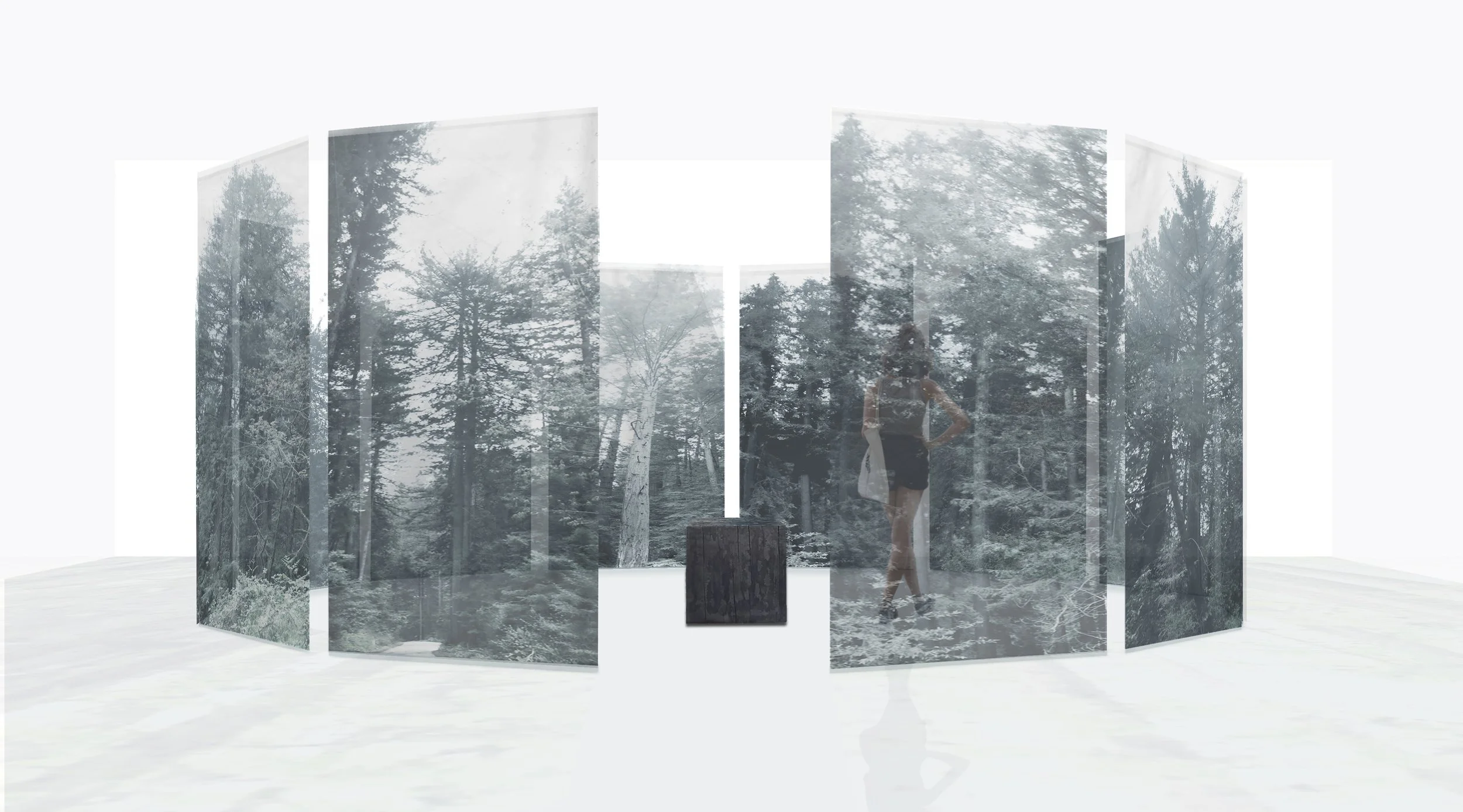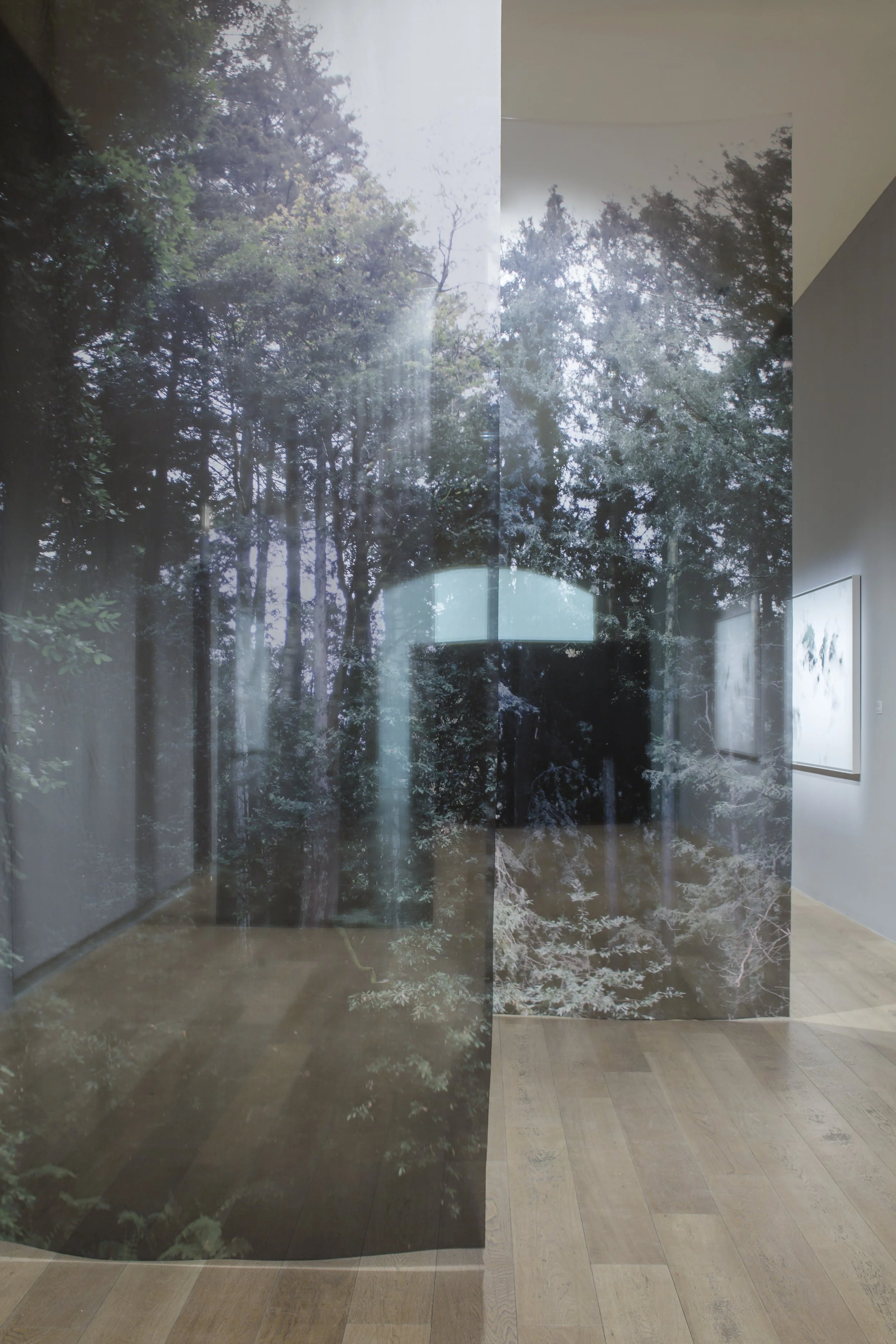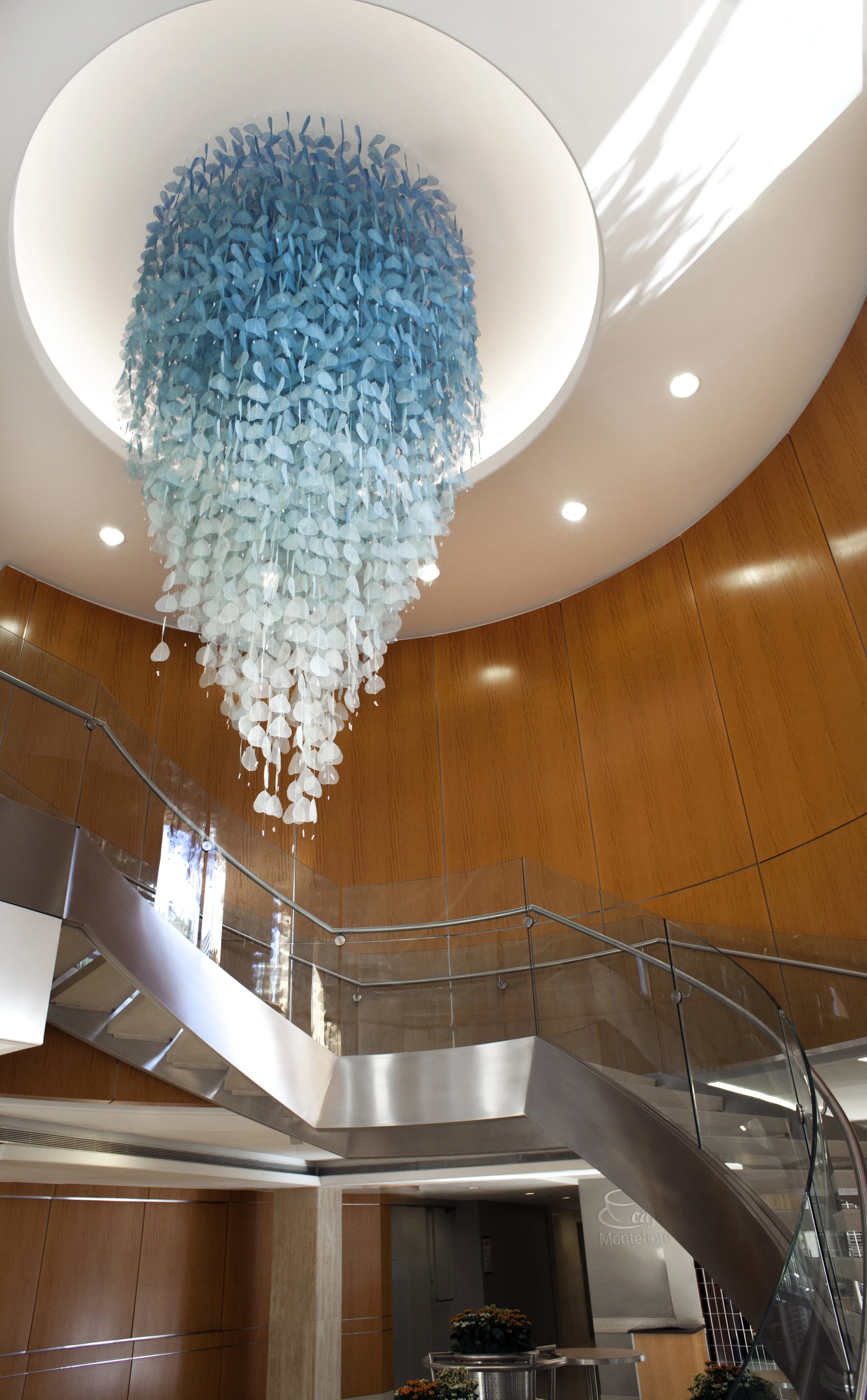MOON ENSŌ (ENGESSŌ 円月相)
Public Commission
Printed Silk Chiffon, Clear Acrylic Rods, Monofilament
132 x 236 x 236 in (335.28 x 599.44 x 599.44 cm)
2025
Location: Art Singapore | Commissioned by ARTSG
Moon Ensō (Engessō 円月相) is a site-responsive installation commissioned for ART SG Singapore 2025. Twenty-nine suspended silk chiffon panels represent each day of the lunar cycle, creating an immersive environment through which the viewer moves as the phases progress. Each panel reflects a moment in the moon’s cycle, revealing both continuity and impermanence. For millennia, the moon has marked the passage of time through its precise and endlessly recurring phases.
In Zen calligraphy, an ensō is a single brushstroke circle that embodies present awareness and holds multiple meanings, such as enlightenment, void, elegance, and the universe. Like many ideas in Zen thought, the ensō defies precise definition or fixed logic. It invites an experiential understanding that arises through mindful presence. The ensō contains paradoxes such as emptiness and fullness, presence and absence, beginning and end. Engessō, the “moon circle,” is a specific form of ensō associated with the full moon. It symbolizes illumination, completeness, and non-dual awareness, among other interpretations.
Moon Ensō embodies these principles physically. It translates the lunar cycle into an experience the viewer inhabits, where time is both continuous and impermanent. The installation originates from Ando’s Moon Almanac, a daily drawing practice sustained over two and a half years during the COVID-19 pandemic. Expanded to architectural scale, it transforms this quiet meditation on time into a tangible form the viewer can enter. The lunar cycle becomes an enduring presence rather than a distant image.
Moon Meditation Hut (2020) is a site-specific installation located at Bhumi Farms in East Hampton, New York. The work reimagines the traditional Japanese chashitsu (tea hut) as an inclusive space for reflection and lunar observation. Constructed from linen panels dyed with natural indigo, the structure also featured phosphorescent paint that absorbed sunlight during the day and emitted a soft glow at night, functioning as a barometer for the amount of daylight received. Created during the COVID-19 pandemic, the hut is part of Ando’s Indigo Moon Almanac project, a durational drawing practice in which she documented the moon’s nightly phases beginning with the first lockdown in New York in March 2020 and continuing until 2022, when the governor officially lifted the city’s mask mandate.
銀河 Ginga (The Silver River in the Sky) was a monumental outdoor installation commissioned by Socrates Sculpture Park in Queens, New York, for the 2019 exhibition Chronos Cosmos: Deep Time, Open Space. The title Ginga translates to “silver river” or “galaxy” in Japanese, referencing the Milky Way and drawing from East Asian cosmological traditions, where the galaxy is envisioned as a celestial river flowing across the sky. Spanning 200 feet in length and measuring 10 × 3.5 × 200 feet, the work was composed of printed fabric and stainless steel. The installation formed a circuitous canopy of undulating chiffon, patterned with images of clouds and suspended above the earth. As wind moved through the park, the fabric gently shifted, creating a dynamic, meditative environment where viewers could witness the ever-changing interplay of light, shadow, and movement.
Ginga connected two temporal and natural phenomena: the flowing water of a river and the distant movement of stars. These elements served as metaphors for time's passage and the continuity between the terrestrial and the celestial. Installed along the East River shoreline, the work harmonized with its surroundings, encouraging reflection on both planetary and cosmic scales of experience. The installation exemplified Ando’s commitment to creating works that bridge the natural world with human perception, highlighting impermanence, transformation, and the poetic structures through which we understand time and existence.
WAVES BECOMING LIGHT
Printed Silk, Clear Acrylic Rods
132 x 44 x 84 in (335.28 x 111.76 x 213.36 cm)
2019
Location: Cornell Art Museum
Waves Becoming Light is an installation composed of suspended silk panels that respond to the subtlest movements of air and light. Drawing inspiration from a line by the 13th-century Zen master Eihei Dōgen—
“[Being illuminated by] the moon dwelling in the quiet mind,
even the waves are breaking down and becoming light.”
Each diaphanous panel is printed with delicate wave imagery and suspended vertically in parallel layers, creating a translucent corridor of motion and light. As the panels shift, they cast rippling shadows across the space, forming an ever-changing field of perception. The silk behaves like waves: it undulates, dissolves, and appears ephemeral.
Aurorae was a monumental installation featured in the Nassau County Museum of Art’s 2019 exhibition Energy: The Power of Art. Suspended in the museum’s Mrs. Vincent de Roulet Gallery, the work consisted of translucent fabric hanging from a spiral aluminum structure, measuring approximately 238 x 120 x 120 inches. The installation transformed the gallery into an immersive environment evoking the aurora borealis, as light passed through the fabric and created shifting atmospheric patterns across the space. The result was a meditative, luminous experience that engaged viewers in the intangible beauty of natural phenomena.
Aurorae exemplified Ando’s focus on light, transience, and the interplay between the material and immaterial. The work aligned seamlessly with the exhibition’s central theme of energy by giving visual form to invisible atmospheric forces and evoking the quiet power of auroral motion.
The exhibition Energy: The Power of Art featured a wide-ranging group of artists whose work engaged with scientific and metaphysical ideas. In addition to Ando, the show included works by Jackson Pollock, Alexander Calder, Jasper Johns, James Rosenquist, Julie Mehretu, Frank Stella, Joseph Cornell, Man Ray, Richard Pousette-Dart, Barbara Prey, Doug Argue, Rachelle Krieger, Scott McIntire, Keith Sonnier, and Mark Tobey.
The museum collaborated with institutions such as Brookhaven National Laboratory and the Tesla Museum, incorporating scientific imagery and even a working cloud chamber to explore themes of radiation, electromagnetism, and the invisible energies that shape life and the cosmos. In this context, Ando’s Aurorae offered a contemplative response, connecting visual experience with elemental physics and natural phenomena.
Ryōanji is a sculptural installation by Miya Ando, featured in her 2019 solo exhibition Form is Emptiness, Emptiness is Form, curated by Bridget Bray at Asia Society Texas Center. The exhibition’s title draws from the Heart Sutra, a foundational Mahāyāna Buddhist text that teaches the non-duality of form and emptiness, understood not as opposites but as mutually arising aspects of the same reality.
At the center of the exhibition is Ando’s reimagining of the karesansui (dry landscape) garden of Ryōanji Temple (龍安寺) in Kyoto, long regarded as one of the most rigorous visual articulations of Zen thought. The historic garden comprises fifteen stones positioned so they can never be seen all at once, set in meticulously raked gravel, forming a spatial composition of formal restraint and perceptual ambiguity. Ryōanji reduced nature to its essence, evoking landscape without imitation. This approach has deeply influenced Ando’s practice. It also represents one of the earliest known examples of pure abstraction in art, anticipating core principles of minimalism, experiential engagement, and conceptual space centuries before such ideas were formally named in modern and contemporary art.
Ando’s installation presents a precisely scaled version of the original garden, replacing each stone with a charred wooden cube made using shou sugi ban, a traditional Japanese method of preserving wood through fire. Treated with silver nitrate, parts of the surfaces reflect and dissolve into their surroundings, registering the passage of light, oxidation, and time. By translating natural stones into minimalist geometric forms, Ando explores the abstraction already latent in the original site. The use of charred wood heightens the sense of temporality and engages the principles of wabi-sabi, particularly its embrace of impermanence, imperfection, and natural transformation.
Sora Versailles was a monumental, site-specific installation commissioned for the inaugural Faena Festival in Miami Beach, titled This Is Not America. The work transformed the exterior of the historic Versailles Hotel by wrapping it in a translucent scrim printed with photographs of the Miami sky at dusk and dawn. Clouds drifted across sheer fabric panels that cloaked the building’s façade, dissolving its solidity into a veil of atmosphere and light.
The title, Sora Versailles, uses the Japanese word sora (空), which means “sky” or “emptiness,” invoking a dialogue between natural impermanence and architectural grandeur. By covering the hotel in sky, Ando effectively camouflaged it against its surroundings, dematerializing the building and rendering it a hovering apparition. It no longer stood as a monument to permanence but appeared instead as a mirage suspended in light.
Moonlit Clouds (2018) is a large-scale, site specific installation commissioned as a PROJECTS Special Artist Commission for PULSE Art Fair in Miami Beach. Installed in the entrance pavilion at Indian Beach Park, the work consisted of suspended silk panels printed with photographic images of night clouds taken over the Miami coastline. Described by the fair as a “gossamer forest of clouds,” the installation created a corridor of translucent fabric that shifted with the ocean air. The panels caught passing light and cast shadows that moved across the space, forming a quiet, atmospheric passage.
The work explored the moment when form begins to disappear. Clouds at night often slip from view, merging with the sky unless briefly revealed by reflected light. Moonlit Clouds gave shape to this condition. The layered silk responded to the surrounding air and light, allowing viewers to register change through movement and the gradation of tone. What emerged was a space where perception depended on attention, and presence was defined by its transience.
The Cathedral is an immersive installation inspired by a striking natural phenomenon observed in old-growth redwood forests: a concentric ring of trees surrounding a central, mature “mother” tree. This ecological formation, documented in the Santa Cruz Mountains where Ando once lived, exemplifies complex intergenerational relationships and physiological interdependence within forest communities. The mother tree disperses seeds that germinate in a roughly circular pattern around her base, producing a ring of progeny trees that mature into a distinct concentric canopy. Even after the mother tree suffers severe damage or death, often due to lightning, the surrounding trees continue to sustain it through interconnected root grafts, transferring nutrients like glucose that sometimes prolong its survival for decades. This biological exchange reveals the forest as an interconnected network, where trees function less as isolated individuals and more as components of a cooperative whole.
The installation materializes this ecological and symbolic reality through silk chiffon panels. The fabric’s gossamer quality evokes the fragility and ghostlike presence of old-growth redwoods, many of which are disappearing under environmental threats. The piece also serves as a metaphor for human society, examining how survival depends on mutual support, shared resources, and interconnectedness.
The Wishing Mandala (2017) was a participatory installation commissioned by and exhibited at the Rubin Museum of Art in New York. Composed of dyed Bodhi (Ficus Religiosa) skeleton leaves suspended with monofilament on archival ragboard, the 72 × 72-inch piece invited visitors to engage directly with the artwork. Guests were encouraged to make a wish and place a leaf onto the mandala, fostering a communal space for reflection and intention-setting. The Bodhi leaf, significant in Buddhist tradition as the tree under which the Buddha attained enlightenment, symbolizes awakening and spiritual insight. By incorporating this element, Ando connected the installation to themes of impermanence and transformation. The interactive nature of the piece emphasized the collective human experience, allowing participants to contribute to the evolving mandala and engage in a shared contemplative practice.
Redwood (Spirit) is an exploration of impermanence, perception, and the interplay between material and atmosphere. The work consists of semi-transparent silk panels printed with photographic images of towering redwood trees, the tallest and among the oldest living organisms on Earth, now diminishing in range and number due to environmental change and human activity. These vertical forms echo both the scale of the trees and the architecture of the space, yet their sheer, weightless surfaces defy solidity, offering a spectral encounter rather than a representational one. The effect is not fixed but spatial and temporal; the viewer moves through its apparition rather than simply observing it. Ando’s use of silk and diaphanous fabric reinforces her interest in liminal states. The material functions as a threshold between visibility and disappearance, between image and experience. Redwood (Spirit) engages with the spirit of place by rendering landscape not as external terrain but as internal condition.
Meditation Room is a site-specific installation, created in 2016 at the Nippon Club in New York City to commemorate the victims of the 2011 Tōhoku earthquake and tsunami. The work invited quiet reflection and remembrance, centering on a sparse yet intimate arrangement: two tatami mats enclosed within translucent walls made from pale pink Bodhi leaves, their cellulose removed to reveal lace-like vascular structures. These suspended leaves softly filtered the ambient light, creating a hushed, contemplative atmosphere within the space. Outside the room’s threshold, two pairs of cast steel geta, one adult sized and one child sized, were placed as though recently removed.
Emptiness The Sky (Shou Sugi Ban) is a meditative installation presented at the 56th Venice Biennale in 2015 as part of the Frontiers Reimagined exhibition at the Museo di Palazzo Grimani. This 7 foot (2.1 meter) cubic structure is clad in shou sugi ban, a traditional Japanese technique of charring wood to preserve and strengthen it. The charred exterior evokes a sense of resilience and transformation, reflecting Ando's interest in impermanence and the passage of time.The cube itself is conceived as a contemporary interpretation of a traditional Japanese tea room, a space historically dedicated to quietude, ritual, and the aesthetics of simplicity. Inside the cube, the space is lined with a series of contiguous paintings that form a continuous horizon line running along all four walls. The unbroken, floating horizon suggests the Buddhist concept of kū (空), a word that means both “sky” and “emptiness,” transforming the interior into a void like space. The contrast between the scorched, opaque exterior and the ambient, almost immaterial interior invites stillness and introspection, offering viewers a moment to encounter emptiness not as absence, but as presence, open, boundless, and aware.
Ascension Leaves is a large scale suspended sculpture installed in 2015 in the atrium lobby of Montefiore Medical Center’s Moses Campus in the Bronx, New York. Commissioned by The Fine Art Program and Collection at Montefiore Einstein, the installation consists of over 6,500 hand dyed Bodhi (Ficus religiosa) leaves, the same species of tree beneath which the Buddha attained enlightenment. The leaves have had their cellulose removed, leaving behind delicate, lace like skeletons. Arranged in concentric circles and suspended on varying lengths of monofilament, they are dyed in a gradient of cerulean blue, with tonal variations determined by the duration of dye immersion. Quartz crystal weights at the bottom of each strand allow the leaves to shift gently in response to ambient air currents, introducing a subtle sense of movement to the space. The sculpture hovers above a circular stairwell and can be experienced from multiple vantage points, both from below and from the upper level. Ando has continued her engagement with healthcare settings through a series of permanent commissions that reflect her interest in creating contemplative spaces for healing and reflection. These include Tides at Memorial Sloan Kettering’s Josie Robertson Surgery Center in New York, Quietness in the nondenominational chapel at San Francisco General Hospital, and a commission for the RCINJ Morris Cancer Center Art Program at Rutgers University.
Kōyō is an installation titled after the Japanese word for the turning of autumn leaves. The work features hundreds of preserved bodhi leaves suspended in vertical strands, each dyed in a shifting sequence from green to gold, crimson, and brown. These colors trace the visible arc of seasonal change, drawn from the natural palette of autumn forests. The installation draws on momiji gari (紅葉狩り), the centuries old Japanese practice of observing the changing leaves. Momiji gari is a quiet encounter with natural cycles that invites attentiveness and reflection. Rooted in the aesthetic of mono no aware (物の哀れ), it reflects a worldview that embraces the beauty of impermanence. Inspired by Japanese poetry, especially waka and Heian era verse, Miya Ando’s Kōyō installation references the literary tradition in which autumn leaves evoke transience, emotional depth, and the passing of time. In Buddhist thought, the falling leaf becomes a metaphor for mujō, or impermanence, the essential condition of existence. The bodhi leaves, lightweight, skeletal, and responsive to air, hover in a suspended field of transition. Color becomes a language of time. The installation offers not a depiction of landscape, but an unfolding experience of change.
Obon (Puerto Rico) is a large scale, site specific installation commissioned by the FIST Art Foundation in 2012 and located in Dorado, Puerto Rico. Spanning 100 by 100 feet, the work consisted of 1,000 hand painted Bodhi leaves (Ficus religiosa), the species of tree under which The Buddha gained enlightenment. Each leaf had its cellulose removed, leaving behind only the vascular structure, the intricate network of veins that forms a lace like, skeletal pattern. Coated with resin and a non toxic phosphorescent pigment, the leaves absorbed sunlight by day and emitted a soft glow by night as they floated on the surface of a pond. The installation responded subtly to its environment, acting as a barometer of atmospheric light. On bright days, the leaves absorbed more solar energy and glowed more intensely by night, rendering visible the natural rhythms of illumination and shadow, presence and disappearance. The project draws inspiration from the Japanese Buddhist festival of Obon, a tradition in which the spirits of ancestors are believed to return home for a brief visit over the course of three days. At the close of the festival, lanterns are floated on bodies of water as a symbolic farewell, guiding the spirits back to the netherworld. Ando reimagined this ritual using luminous skeleton leaves in place of lanterns, merging spiritual tradition with the natural phenomena of Puerto Rico’s bioluminescent ecology. The work offers both a meditation on impermanence and memory, and a quiet commentary on the fragility of these ecosystems.
Iterations of this piece have been exhibited in multiple contexts: in Raising the Temperature: Artworks in Environmental Reactions at the Queens Museum of Art in Queens, New York; as part of the Thanatopolis Outdoor Memorial Sculptureprogram in Norwalk, Connecticut; and in Obon: Temple at the Haein Art Project, Haeinsa Buddhist Temple, South Korea. Each version continues the theme of remembrance through light, scale, and material transformation.
Since 9/11 is a permanent public memorial sculpture in London’s Queen Elizabeth Olympic Park, created from a four ton piece of World Trade Center steel gifted by the Port Authority of New York and New Jersey. Commissioned by the UK educational charity SINCE 9/11, the 28 foot tall sculpture commemorates the victims of the September 11 attacks and serves as a symbol of peace, tolerance, and resilience. Ando, known for her minimalist artwork that explores impermanence and transformation, polished the steel surface to a mirror like finish, turning it into what she described as a “mirror in the sky.” The column reflects the clouds, sky, and surrounding urban landscape, transforming an object of destruction into a contemplative surface that engages with light and the passing of time. The sculpture was unveiled at its permanent site on March 17, 2015. Then Mayor of London Boris Johnson played a key role in securing the work's final placement. Sir Simon Schama, who also spoke at the unveiling, echoed this sentiment, noting that the sculpture’s reflective surface integrates it into the life of the city, offering a quiet but powerful space for remembrance and continuity.
“So all those memories of unimaginable horror will be present at this place and are embodied in Miya Ando’s extraordinary sculpture... and I also want to pay tribute to Miya and everybody responsible. In an age where contemporary art is very often about, if you are lucky, the quick hit of wit, it is possible also to make great modern and contemporary art which is about something important, something serious, something transforming, and that’s what Miya has done. But she has done it because it is not just a kind of brutally tragic utterance made out of the debris of the World Trade Centre, but there is also as you will see another aspect to the piece which is a reflection, and the reflection is of where we are now, dear friends... of trains travelling past, of the great pulse of the city, the most brilliantly cosmopolitan city in the world… So it is appropriate that we will see the reflection of sky and movement and the life of the people about us.”
—Sir Simon Schama
Since 9/11 remains one of the only public 9/11 memorials outside the United States, and stands as a testament not only to the tragedy’s global impact but to the capacity of art to hold memory and mirror the resilience of contemporary life.



